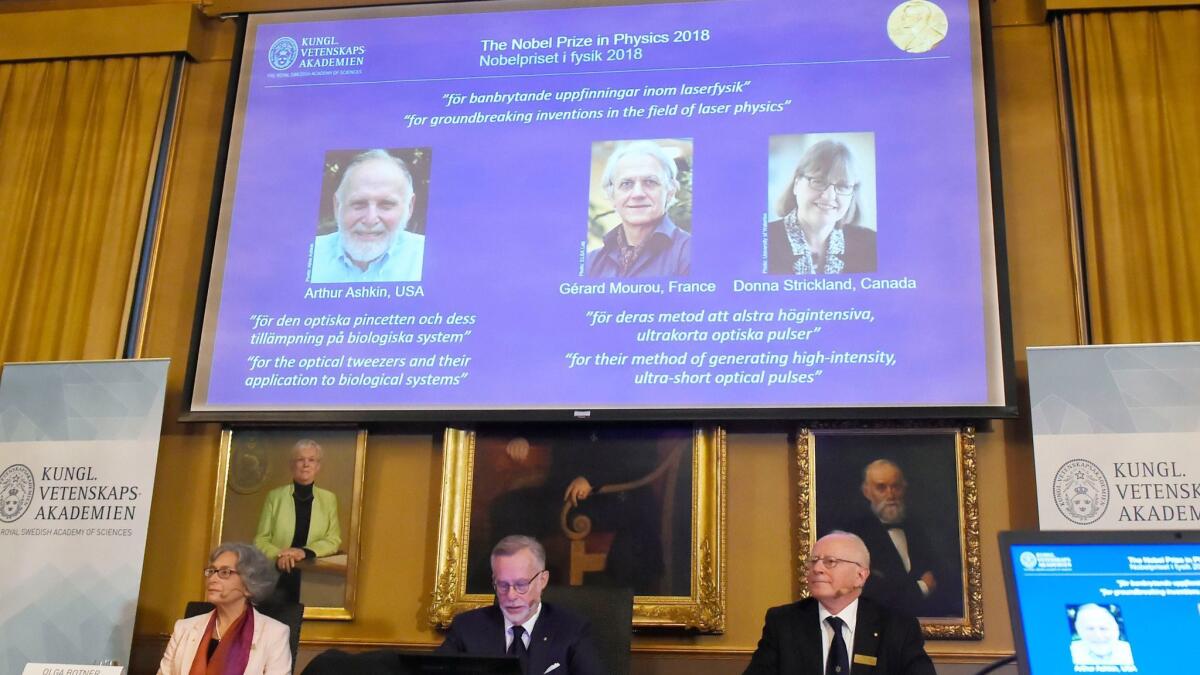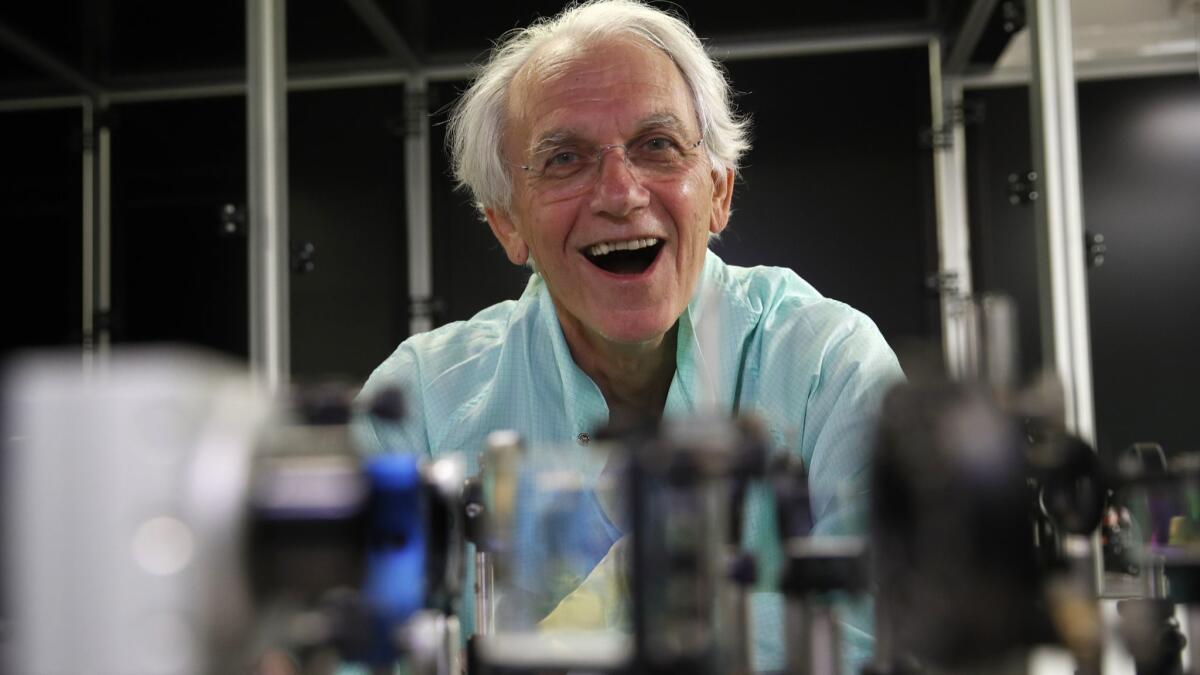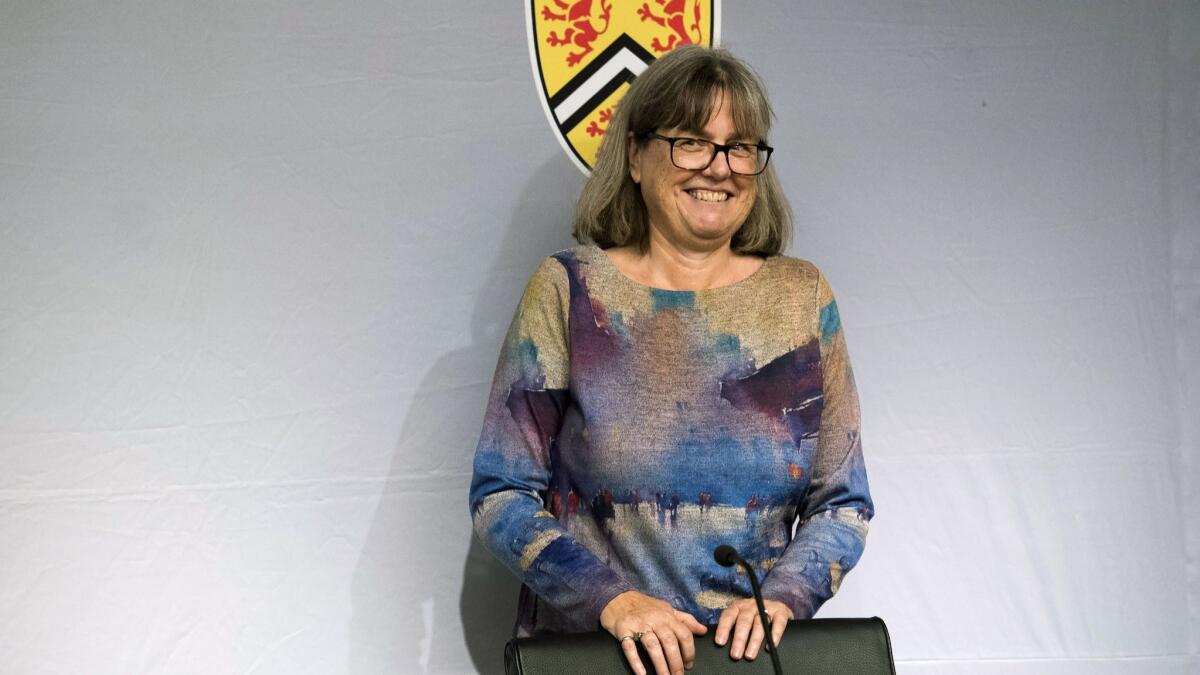Physicists who turned science fiction into reality share the Nobel Prize for their work on lasers

- Share via
Three physicists whose pioneering work transformed lasers from science-fiction fantasy into powerful tools were awarded the 2018 Nobel Prize in physics.
Arthur Ashkin, a researcher at Bell Laboratories in New Jersey, receives half of the $1.01-million prize for inventing “optical tweezers” — focused beams of light that can be used to grab particles, atoms and even living cells and are now widely used to study the machinery of life.
Gérard Mourou, of École Polytechnique in France and the University of Michigan, and Donna Strickland, of the University of Waterloo in Canada, share the other half for work that “paved the way” for the most intense laser beams ever created by humans.
“Billions of people make daily use of optical disk drive, laser printers and optical scanners ... millions undergo laser surgery,” said Nobel committee member Olga Botner after the award was announced Tuesday in Stockholm. “The laser is truly one of the many examples of how a so-called blue sky discovery in a fundamental science eventually may transform our daily lives.”

Strickland is the first woman to be awarded the physics prize since 1963, when Maria Goeppert-Mayer was recognized for her work on the structure of nuclei. Marie Curie won the physics prize in 1903 and the chemistry prize in 1911.
When asked how it felt to become only the third woman to win the physics Nobel, Strickland reacted with surprise.
“Really? Is that all? I thought there might have been more,” she said. “Obviously, we need to celebrate women physicists, because we’re out there. I don’t know what to say. I’m honored to be one of those women.”
Ashkin, 96, is the oldest person to be awarded the Nobel Prize. He would not be available for interviews, the committee said Tuesday morning, because he was too busy working on his next paper.
In a laser beam, light waves are tightly focused, rather than mixing and scattering as they do in ordinary white light. Since the first laser was built in 1960, scientists speculated that the energy of these focused beams could be put to work to move and manipulate objects — a real-life version of “Star Trek’s” “tractor beams.”
“But this was science fiction for a very long time,” committee member Mats Larsson said.
Ashkin spent two decades studying the properties of lasers. He recognized that objects could be drawn toward the center of a beam, where the radiation was most intense. (A committee member demonstrated this phenomenon during the news conference by using a hair dryer to suspend a ping-pong ball in the air.) By further focusing the beam with a lens, he developed a “light trap” that could suspend a small spherical object at its center.
Ashkin used his new tool to hold a particle in place, then an atom, and, eventually, in 1987, a living bacterium. Ashkin even demonstrated that the tool could be used to reach into a cell without damaging the living system.
The tweezers are “extremely important for measuring small forces on individual molecules,” said David Haviland, a member of the Nobel committee. “This has been very interesting in biology, to understand how things like muscle tissue work.”
Atomic physicist Bill Phillips, who shared the Nobel Prize in 1997 for his work on cooling and trapping atoms with lasers, said Ashkin’s discoveries were vital to his own research.
“I feel like I owe a great debt to Art,” he said.
Also in the 1980s, Mourou and Strickland were working together at the University of Rochester to overcome a problem that had dogged laser research for decades: High-intensity laser beams tended to destroy the material used to amplify them. It was as though scientists were trying to boil water in a pot that couldn’t handle such high temperatures.

The Rochester researchers developed an elegant workaround, which they called “chirped pulse amplification,” or CPA. First they stretched out the beam with a mile-long fiber optic cable, reducing its peak intensity. Then they amplified the signal to the desired level before compressing it into an ultrashort, ultrapowerful pulse lasting a tiny fraction of a second.
“Different people were trying to get short pulses amplified in different ways,” Strickland said. “It was thinking outside the box to stretch first and then amplify.”
CPA has been used to take images of split-second processes, such as the interactions between molecules and atoms. It’s also fundamental for laser eye surgery.
The technique is just as important to basic research.
“Fast pulse, high-energy pulses is ... one of the key things that characterizes modern atomic physics,” Phillips said. “There’s so much you can do with [them] to study how atoms behave.”
Strickland was a graduate student at the time of the CPA research; the 1985 article that announced the achievement was her first scientific publication.

Students have historically not been recognized by the Nobel Committee, something that critics say overlooks the work done by young scientists who are more frequently women and underrepresented minorities.
But graduate students are the backbone of most scientific research, often running experiments and doing the detailed data analyses that lead to major discoveries. The prize-winning discovery of pulsars — swiftly spinning cores of collapsed stars — would not have been possible without Jocelyn Bell Burnell, who built the telescope and spotted the first signal when she was earning her PhD. But Burnell was not among the list of laureates for that prize.
The journal Nature reported that the Royal Swedish Academy of Sciences would explicitly call on future nominators to consider gender, geography and topic for the 2019 prizes.
Göran K. Hansson, secretary general of the academy, said Tuesday that the academy is taking these measures “because we don’t want to miss anyone.” But they did not affect this year’s prize: “It’s important to remember that the Nobel Prize is awarded for discoveries and inventions, and those who receive it have made major contributions to humankind, and that’s why they get the prize.”
In a phone interview with the Swedish Academy, Strickland said her favorite application of high-power lasers is something she still demonstrates to undergraduate students in physics lab: white light generation. With this technique, a beam containing a narrow range of wavelengths is shot into a medium such as water, causing the waves to spread out into a rainbow. This is more advanced than Newton’s famous experiment with a prism; whereas he simply spread out light into its component colors, white light generation broadens the spectrum contained within a beam, creating the colored light.
“It’s a remarkable thing to see,” Strickland said, and it took decades for physicists to understand how it worked. “But that’s what scientists like to do, is puzzle over something.”
Kaplan writes for the Washington Post. The Associated Press was used in compiling this report.
UPDATES:
1 p.m.: This article has been updated with additional comments from scientists and more detail about the prize-winning work.
6:20 a.m.: This article was updated following interviews with the scientists, as well as more information about their work with lasers.
This article was originally published at 3:25 a.m.






